Around 150 people died in the recent train accident near Kanpur. The passengers of Indore-Patna Express were in deep slumber, when some 14 coaches of the train were derailed, apparently due to a rail fracture. It is one of the worse rail accidents of recent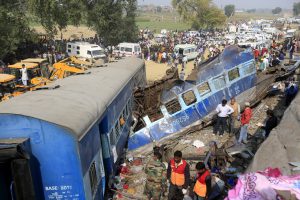 times, almost equally in casualties as that of Gyaneshwari Express in which some 150 had died in 2010, when the train had been derailed by Maoists in West Bengal. The scale of deaths and injuries makes the current accident, one of the worst in the history of Indian Railways. Sadly, going by the things as they are, this accident won’t certainly be the last “major one” in India’s transport sector.
times, almost equally in casualties as that of Gyaneshwari Express in which some 150 had died in 2010, when the train had been derailed by Maoists in West Bengal. The scale of deaths and injuries makes the current accident, one of the worst in the history of Indian Railways. Sadly, going by the things as they are, this accident won’t certainly be the last “major one” in India’s transport sector.
The travesty is that after every such incident, a set of actions/reactions follow almost in an autonomous mode. The opposition will bay for blood, the experts will decry the state of railways, the media will highlight all the unfulfilled promises and commitments, and the rail minister will set up a committee to investigate, promising strictest action possible. As the days pass and the dust settles down, the accident will become a statistic, invoked only in times of similar accidents, largely as an illustration of how “no lessons are ever learned”.
But then running Indian Railways is by no means an easy task. Sample these stats; 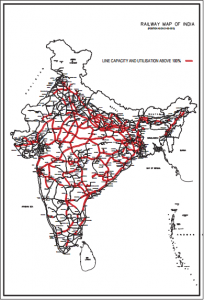 railways have a network of more than 64000 kms in length. It runs around 7000 commuter trains; 12000 long-distance trains and 6000 freight trains this network daily. Around 22 million passengers commute over the network each day. That is the sheer size and scale of this network. Given, the sheer scale, an accident like this in a few years should not raise much eyebrows, after all even Six Sigma allows you a few faults in a million, doesn’t it? But it does and should, because the faults in Indian Railways system can have ghastly repercussions. Imagine, it was a rail fracture in the Kanpur accident (a crack that is a few inches wide on the metal track) that killed so many and injured so many more. Faults on railways are always a killer. Thus, there is just no excuse for them.
railways have a network of more than 64000 kms in length. It runs around 7000 commuter trains; 12000 long-distance trains and 6000 freight trains this network daily. Around 22 million passengers commute over the network each day. That is the sheer size and scale of this network. Given, the sheer scale, an accident like this in a few years should not raise much eyebrows, after all even Six Sigma allows you a few faults in a million, doesn’t it? But it does and should, because the faults in Indian Railways system can have ghastly repercussions. Imagine, it was a rail fracture in the Kanpur accident (a crack that is a few inches wide on the metal track) that killed so many and injured so many more. Faults on railways are always a killer. Thus, there is just no excuse for them.
Realising the dire state of the railways, the minister Suresh Prabhu had proposed to invest ₹ 1,27,000 crore over 2015-19 in safety work, which includes track renewal. In addition to ₹1,02,000 crore to be spent on the locomotives, coaches, etc. And such steps were not the first ones. The previous government had appointed a committee under Anil Kakodkar to enhance railway safety.
Yet, in spite of all the ‘supposed’investment in safety and all the great plans, the real problem lies in the very manner in which the railways is run. The way the organisation (for a want of a better term) is structured, it is doomed for disaster and going bust in the days 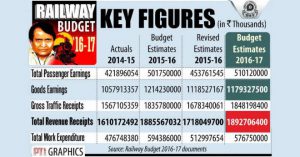 to come. Indian Railways (IR) is right now like a patient that is afflicted with tuberculosis, the symptoms are all there. But if we only concentrate on the manifestation and ignore the ailment, the patient is going to eventually die. The prognosis for IR is similarly dour. And here’s why:
to come. Indian Railways (IR) is right now like a patient that is afflicted with tuberculosis, the symptoms are all there. But if we only concentrate on the manifestation and ignore the ailment, the patient is going to eventually die. The prognosis for IR is similarly dour. And here’s why:
IR is living beyond its pockets — for every 100 bucks that it earns, the transporter is actually spending some 114 bucks. A deficit of straight 14%, that’s crazy isn’t it?
And can you guess what the biggest reason for this business anomaly is, it is the bloody manpower. Don’t get it? Sample this:
IR employs around 1.3 million people. Wages & salaries accounted for around 24% (₹35,565 crore) of the total expenditure of ₹1,46,000 crore in 2014-15. This year’s budgeted wage bill of ₹40,435 crore is almost 25% of the total budgeted expenditure of ₹1,63,000 crore. Add to that, the massive and mammoth pension burden. According to estimates, retirement benefits will account for 27% of total expenses in 2016-17. IR 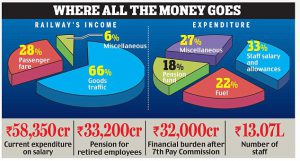 currently pays pension to a whopping 14.3 lakh ex-employees, whereas the number of serving employees is now 13.25 lakh. Thus, our national transporter is paying salaries (retirement benefits) to more number of ex-employees than the one currently on rolls.
currently pays pension to a whopping 14.3 lakh ex-employees, whereas the number of serving employees is now 13.25 lakh. Thus, our national transporter is paying salaries (retirement benefits) to more number of ex-employees than the one currently on rolls.
According to some news reports, if salaries and allowances are viewed along with the growing pension bill, the whole package is going to be three-fourth of IR’s working expenditure budget. While earnings grew typically at a rate of around 10-11% per year, the pension bill grew at 17-18% . This year pension is 34%of its budgeted working expenditure.
So the simple query is; with some 50% of earnings disappearing fast in salaries and pension (and around 70% will in the future), where does IR have the money to invest in infrastructure or maintain its current one?
The trouble also lies in the way the railways are structured. While, it is meant to function like a PSU (generate income and spend money on expenditure), it actually works like ministry, under the lordship of ministers and IAS babus. The result is that unlike say a SBI that can take business decisions, all the ones taken by IR are dictated by political needs or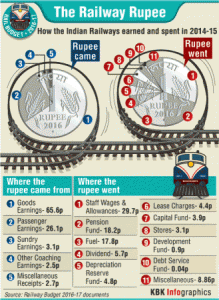 expediency. Hence, even though it is extremely uneconomical, the railways is unable to raise passenger fares. But since, it needs to generate revenue, it keep increasing the freight fares (to cross-subsidise the loss from passenger traffic). Due to the constant rise in freight rates, IR is losing out on freight traffic, result its freight revenues are also on the dip.
expediency. Hence, even though it is extremely uneconomical, the railways is unable to raise passenger fares. But since, it needs to generate revenue, it keep increasing the freight fares (to cross-subsidise the loss from passenger traffic). Due to the constant rise in freight rates, IR is losing out on freight traffic, result its freight revenues are also on the dip.
Currently, the fuel expenses account for 15% of total rail expenses, and the rolling stock for another 20%, leaving nothing but a deficit so as to say. This is the reason, why railways infrastructure spend is so low. Take the case of the Dedicated Freight Corridors (DFC), against a budgeted investment of ₹7,500 crore for DFC projects in 2015-16, it ended the year with an investment of less than half at ₹ 3,500 crore. IR just doesn’t have the money.
And yet, even with the dire finances, every year the rail minister will announce a slew of new trains, new measures, and new additions. Thankfully from 2017, when the rail budget is done away with, all such cosmetic things will not be necessary anymore.
Nonetheless, given the current financial drain on railways, safety will always take a backseat. All those great ideas that come from the various committees will seldom be implemented. So, the signaling will not be hi-tech, the coaches certainly won’t, the computerised-braking systems wouldn’t be implemented, etc. It is due to factors like these that accidents like the recent Indore-Patna one are bound to be repeated at regular intervals.
So, in the coming years, as one boards the trains, saying prayers or promising a coconut to the lords above will be a much safer bet in security than banking on the work done by the 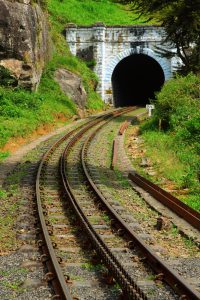 railways. Strangely, almost everyone seems to be oblivious to this singular economic fact. Till the railways resolves its people issues (especially the retired ones), it will never be able to fully run like a professional transporter. It’s ironical that because of the railways caring so much for its ex-employees, the lives of its current commuters are at an increased risk.
railways. Strangely, almost everyone seems to be oblivious to this singular economic fact. Till the railways resolves its people issues (especially the retired ones), it will never be able to fully run like a professional transporter. It’s ironical that because of the railways caring so much for its ex-employees, the lives of its current commuters are at an increased risk.
The fact is that the scenario can be improved. We have in front of us, the instance of General Motors that had similarly close to million people on its rolls, and was facing a massive resource crunch because of the pension payouts. GM over the years, cut the fluff, renegotiated the terms of settlement, and largely averted a disaster.
But then again, IR is not a company like GM that is run on principles of economics, it’s a magic wand used by every government to dole out favours and help politicians make money. Till that is the case, any Tom-Dick or Shankar will be able to predict the doomsday scenario for IR. You don’t need any crystal ball gazing, it is there, right in the budget. Hope Suresh Prabhu has some other ideas on this.;
